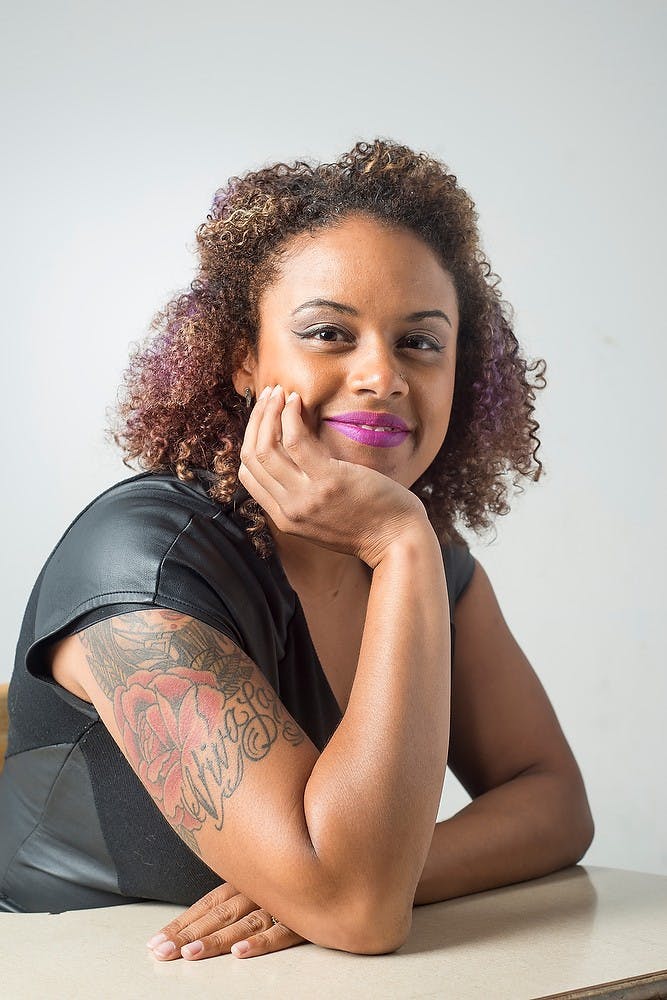And she wears each of them with pride while carrying on her professional responsibilities.
Business and body art do not usually mix, but Torok, executive director of The Firecracker Foundation in Lansing, said that one of the perks of being a self-employed entrepreneur is the freedom to uphold and accept values that she sees as worthy — including tattoos and piercings.
MSU students enter the workforce by the thousands each year, hoping to find success in a judgment-free zone. And today’s workforce is evolving in just that way as it becomes more digitally inclined, visually engaging and culturally diverse.
As the popularity of body art and modification rises, hiring practices and views on tattoos and piercings have begun to see a shift as well.
A form of expression
Packaging junior Becca Jarvis has five tattoos. Each stands for something personal and significant. Her tattoos include an infinity sign with initials on the inside of her left bicep, an equal sign on her right calf, a star on her left wrist and words on the inside of each foot saying “I love you” in her parents’ handwriting.
“I got the ones with words or letters for my family to keep them near my heart forever, and the equality ones are for my own sake,” Jarvis said.
Jarvis’ family still worries that she won’t be able to get a job as a result of the tattoos.
Theatre freshman Mike Merluzzi has both ears pierced and a tattoo on his ribs saying, “An act of God and nothing less will be accepted.”
Merluzzi said his tattoo expresses his disbelief in blind faith.
Placement was a key aspect for both students. They placed their tattoos so they could be easily hidden for potential employment requirements.
“I knew getting a tattoo could hinder my chances of getting hired (as an actor), so I got it in a very easily concealable place,” Merluzzi said.
Human development and family studies sophomore Abby Cieslak said her tattoos and piercings have not affected her job search or employment because they can be hidden when needed.
“I didn’t want to get any visible on my arms yet or anything, though, because some places don’t allow that,” Cieslak said.
Old stigmas
Jarvis said she believes there is still a stigma connected to tattoos and piercings in the minds of older generations in the workforce because typically only criminals and outcasts had them in decades past.
However, as the norm evolves to making a person’s body into a personal and sentimental work of art and the younger the hiring staff of a company is, the less of an issue body modification is, said Jarvis.
UZoom Media CEO Anne Craft said she does not find tattoos or body modification to be professional in the workplace.
Support student media!
Please consider donating to The State News and help fund the future of journalism.
“If you’re in a job where you are expected to wear a suit or be in a professional environment, you should not have tattoos that show,” Craft said. “You should be able to cover them up with professional clothing.”
Several companies have strict rules in place to control what their employees look like.
Bill Bettis, a recruiter for United Parcel Service said the company does not allow men to have any piercings and allows women to have only one post earring in each ear.
Jianna Zanoni, an employee at Splash of Color Tattoo and Piercing Studio, located at 515 E. Grand River Ave., was let go from a previous position at a post office because of her multiple tattoos and piercings.
On the job hunt after, she was turned away from a number of establishments because stores “didn’t want that look in their store.”
However, Kris Lachance, owner of Splash of Color Tattoo and Piercing Studio, said that she has seen tattoos and body piercings become more mainstream over the years.
This rise in popularity is part of the catalyst for a perception change in the professional world.
“That’s kind of been my goal to change that perception because on the whole we are a very passionate industry,” Lachance said on the tattoo and piercing industry. “This is a profession.”
Changing perceptions
Perry Stratton, a tattoo artist at Splash of Color Tattoo and Piercing Studio, said that tattoos are not solely restricted to students.
Stratton sees a number of employees from the capitol, lawyers and surgeons coming in to get tattoos done.
Additionally, one sector of the workforce that seems to be particularly changing their tone on the issue is independent businesses.
Torok said she looks at tattoos and piercings as a positive attribute of a potential new employee.
“I’m always a little confused as to why they’re not allowed in professional settings just because I think that ... it’s a waste of talent,” Torok said. “It’s just another aspect of them.”
Lachance is also working to redefine professionalism, or at least broaden the idealized candidate.
Because she appears in the professional world so often, she stopped adding to her tattoo arm sleeves and chest tattoo so they can be covered up.
Lachance also works as an authorized outreach instructor for the Occupational Safety and Health Administration, specifically the tattoo and piercing industry. Being an industry health and safety expert, she sits in on state and local health department body art board meetings, writes industry regulations and teaches classes on industry safety and health.
When she’s inside her tattoo studio, Lachance said she is free to show off and be proud of her tattoos.
“You’ve gotta give respect to get respect,” Lachance said. “We establish a rapport, and then I can take my blazer off.”
While Craft prefers a more traditional look, she said that body art does not speak to professional competence.
“The best assistant I have ever had working for my company had tattoos all over the place, and she was awesome,” Craft said.
Lachance said that while society and professionals have come a long way in recognizing body modification and adapting slightly to accommodate it, there is still a long journey ahead before it places no influence on hiring practices.
“I’d like a world where nobody’s judged. ... But it’s never gonna happen, I don’t think,” Lachance said.
Discussion
Share and discuss “Inked” on social media.




